Let's cut through the BS and establish the real difference between monofilament and fluorocarbon. These types of fishing line are not the same, nor is one better than the other. They are both unique, and a good angler uses their uniqueness to excel in different scenarios.
Difference Between Monofilament and Fluorocarbon
Monofilament and fluorocarbon look the same, right? They are both somewhat transparent, with a slick texture and even a little shiny. Given this, novice anglers fail to realize the difference between monofilament and fluorocarbon.
Quick Breakdown
So, let me give you a quick breakdown then a more in-depth explanation.
Fluorocarbon is...
- more abrasion resistant
- sinks in the water
- nearly transparent
- UV resistant and zero water absorption
- stretches less than monofilament
- more costly
Monofilament is...
- suspends in water
- stretches more than fluorocarbon
- susceptible to water absorption and UV damage over time
- much cheaper than fluorocarbon
So this means...
Since both lines have different characteristics, they will perform differently, therefore having different applications.
Fluorocarbon is best suited for deepwater jigging, cranking or any kind of application that requires the lure to sink in the water column.
Fluorocarbon also does well when dealing with "spooky" fish. Because it's transparent, it is difficult for fish to see underwater.
Monofilament is great for topwater lures. Fluoro would sink when you stop retrieving, potentially dragging the topwater down or getting hung up on the bottom.
Because monofilament stretches, it is also a good leader line to use. This removes shock from the fish strike, making tackle less likely to break.
Difference Between Monofilament and Fluorocarbon - A More Detailed Look
Only hardcore anglers thirsty for knowledge would keep reading! :)
So let's explore the difference between monofilament and fluorocarbon fishing lines.
Manufacturing Process
Monofilament and fluorocarbon are both created using a manufacturing process called "extrusion".
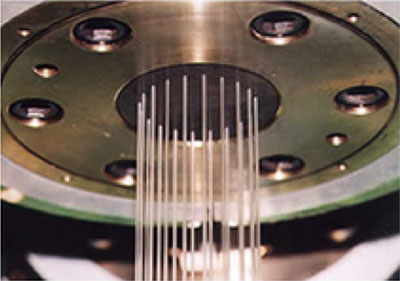
Liquid nylon being extruded to create a single filament, or "mono-filament".
Extrusion is the process of taking the liquid form of a substance and pushing it through a tiny hole, in order to create a single filament, or mono-filament, of line.
This leads novice anglers to believe that fluorocarbon is the same as "monofilament" and therefore the same kind of fishing line, just more expensive and supposedly "superior".
This is simply not true.
What they're made of.
The major difference between monofilament and fluorocarbon is their unique molecular composition.
In short, they are simply not the same.
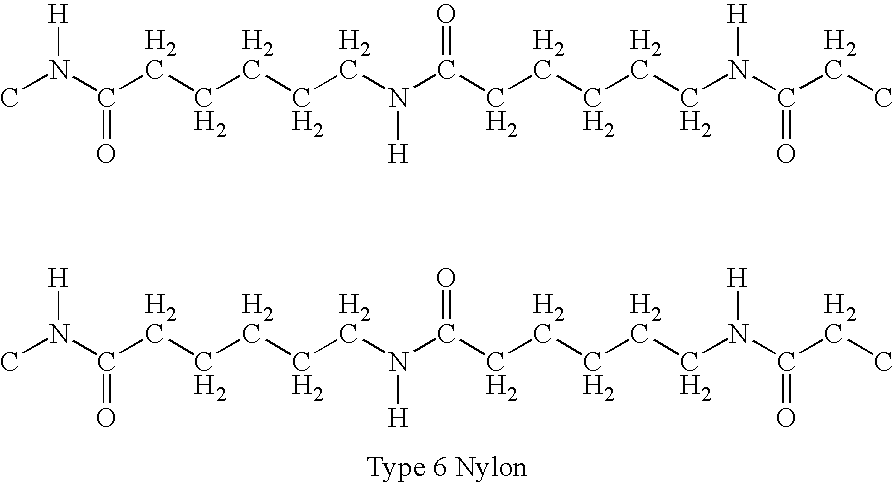
Monofilament has nitrogen and oxygen in its makeup, while fluorocarbon does not.
Fun Fact
"Monofilament" is really Nylon, the same material used to make toothbrushes and those pantyhose Hooter's girls wear.
Anyways, fluorocarbon has fluorine, whereas monofilament doesn't.
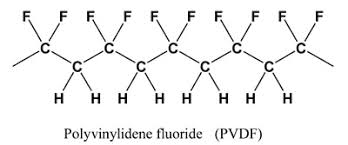
Since they are both made from different materials, they inevitably have different characteristics.
Density
Both fishing lines have different densities:
- Monofilament - 1.15 g/cm3
- Fluorocarbon - 1.78 g/cm3
And for comparison:
- Freshwater - 1 g/cm3
- Saltwater - 1.02 - 1.03 g/cm3
Fluorocarbon is denser than monofilament, making it more resistant to abrasion.
Monofilament is nearly the same density as water, making it neutral-buoyant.
This is the opposite of fluorocarbon, which is denser than both, allowing it to sink.
Strength
Fluorocarbon does not stretch as much as monofilament (though it does stretch a little), making it more sensitive.
Given it's qualities, fluorocarbon is also UV resistant and doesn't absorb water, increasing its lifespan.
Monofilament stretches more, making it more shock-resistant than fluorocarbon.
Visibility
Monofilament and fluorocarbon have different refractive indexes, meaning one refracts light less than the other.
Fluorocarbon refracts less light than monofilament, increasing its invisibility.
Cost
Compare prices between the two next time you are at the tackle store. The difference will be obvious!
The reason why fluorocarbon is more expensive than monofilament is because the material and extrusion process is more costly.
How does this difference between monofilament and fluorocarbon apply to inshore anglers?
Every difference between monofilament and fluorocarbon is an advantage that we, as inshore anglers, should be exploiting.
Remember One fishing line is not "better" than the other. Wise anglers know how to use both to handle different scenarios.
This is not lost on bass anglers, as they fish bodies of water with a lot more pressure than we do.
They must make the best use of every tool in their toolbox or, in our case, a tackle box!
Monofilament's Inshore Applications
Recall that monofilament is nearly the same density as water, being only slightly heavier.
This makes it "neutral-buoyant" meaning that it doesn't really sink or float.
It just stays in one place, at that one depth.
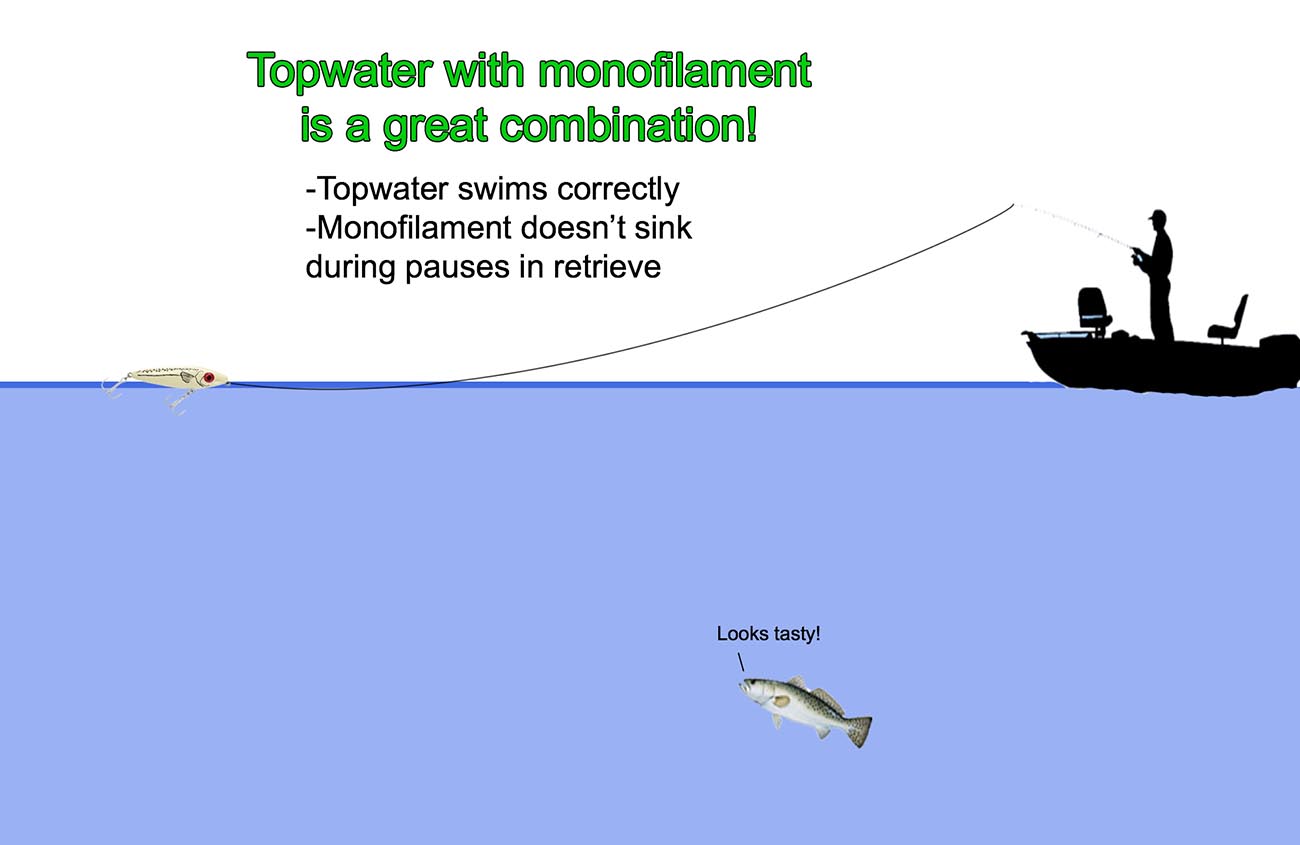
Topwater Lures
This makes it an excellent candidate for topwater lures, especially those requiring pauses in the retrieve.
If you were to use fluorocarbon for topwater lures, you'd be awfully surprised when the topwater doesn't perform correctly because it's nose is being pulled down by the weight of the fishing line.
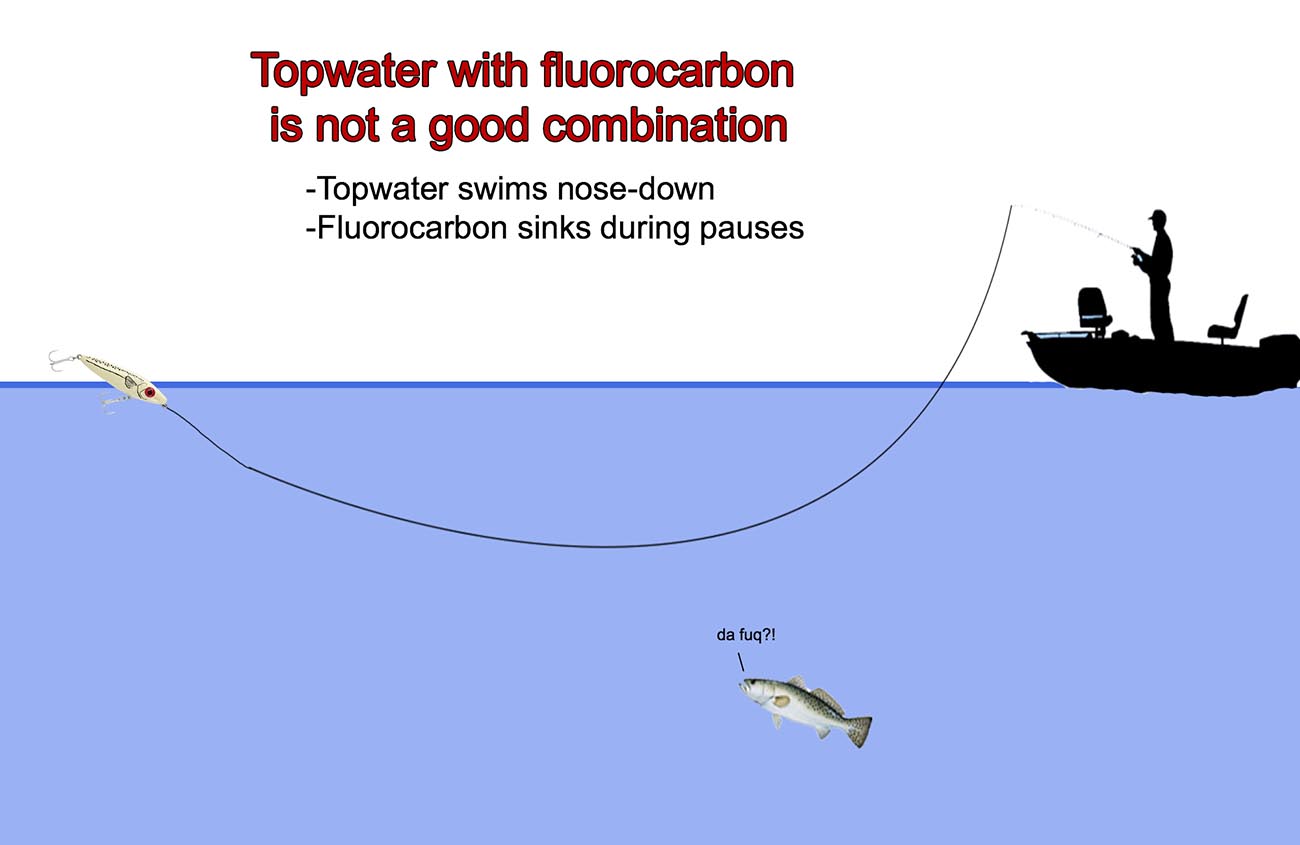
If I weren't using braided line for popping corks, I'd definitely use monofilament!
Shock Leader
Because monofilament stretches, this makes it an excellent shock leader, especially for braided line (which hardly stretches at all).
The sudden "shock" of the line going from limp to taut during a hard fish strike could cause it to fail, especially at the knot.
Have you ever seen someone bungee jump?
The rope used is designed to stretch, taking the shock out of the fall when the jumper runs out of slack.

Otherwise, the shock of suddenly running out of slack would seriously injure the jumper!
Line Backer
Monofilament makes a great "backer" on spools to reduce overall fishing costs.
Why spool 200 yards of PowerPro fishing line onto your reel when you can spool 75 yards of monofilament, join it to your braided line, then spool on the 65 yards of braided line you will actually use?
This also applies to fluorocarbon, especially since it's more expensive!
High Visibility
Monofilament comes in different colors, making it even more useful!
Different colors help when untangling lines, but also for "line watching".
This involves watching a slack line for movement to detect a bite.
A brighter colored line is easier to see and makes this technique easier to execute.
Fluorocarbon's Inshore Applications
Remember, fluorocarbon sinks, is nearly invisible underwater, and has more sensitivity.
Deepwater Jigging
"Deep" in the realm of inshore fishing can be anywhere from 10ft to 30ft, give or take. Jigging in deeper water is radically different from jigging in shallow water.
An angler's understanding of fishing deep water must operate at an expert level to catch fish.
This is where fluorocarbon comes into play.
Since it sinks, it can only help lures reach the bottom of the water (which is the goal in deepwater jigging). Theoretically, this allows for less of a "bow" in the fishing line.
Combine this with fluorocarbon's sensitivity to achieve improved hook sets. Fish strike much softer when they are cold, like in the winter. A faint bite is more easily detected with the sensitivity of fluorocarbon.
Also, one can use a lighter jighead, allowing for a slower, more uniform fall.
If you want to learn more about jigging, then please consider my ultimate guide to jigging speckled trout.
Superior Presentation
From my experience, over the the winter of 2016 - 2017, an 1/8oz jighead paired with 12lb fluoro outperformed a 1/4oz jighead with braided line.
Despite casting at the same spot, using the same technique with similar rod/reel combos, the fluorocarbon and light jighead consistently got more bites.
"Spooky" Fish
Spooky fish are fish that aren't eating because they are easily scared by anything and everything.
One way to get them to strike is to use a fluorocarbon leader.
Recall the low refractive index of fluorocarbon, and remember that fish will be less likely to see the line and become "spooked".
Conclusion
There is a big difference between monofilament and fluorocarbon, and one is not "better" than the other.
They are just different, and good inshore anglers know how to harness those differences.
Those who do enjoy more success than those who don't.

good reading. funny as well. thanks for the good content
I stream fish with floro, because I want to get down deep into pools below tail race rocks, I do however hang up more than with mono, but I definitely catch more large fish. Mono is excellent for lake fishing, l do a lot of sliding weight lake fishing for trout, kokanee, and char. Floro will find it’s way into the rocks, where Mono will glide across them on a windy day.
Thanks for reading, Chuck!
This is great information. Now my fishing trips should be more productive
Glad you liked it! Thanks for reading.
Awesome!
Thanks for reading, Robert!
I’m not sure if you’re in Louisiana or not, but a cold front rolled through this morning and fall fishing is in full swing.
I have a free course at LAFB Elite you may be interested in. It’s called Fall Fish Location and you can sign up here:
https://www.lafbelite.com/course/easily-locate-speckled-trout-redfish-during-the-fall-pattern/
Tight lines!
A great article, thank you
Yeah, I get he was testing abrasion. It was pretty cool.
I know Luke soaked the mono for 15 minutes, but I don’t know if that’s enough. It’s definitely better than dry.
And I hear you on the marketing. I don’t how much you follow my blog, but I absolutely despise marketing. lol
In fact, there was a cool experiment testing the effective noise of rattling lures.
I can’t recall when, but it was conducted by Dr. Hong Yan and researcher Benjamin Messer at the Frankfort State Fish Hatchery in Kentucky.
They tested 23 rattling lures and discovered only 3 produced a dominant frequency within the hearing range of largemouth bass.
LOL
Think of all the hype and marketing that goes into lures, just to have researchers prove fish can’t hear them.
Anyways, thanks for commenting, Dan.
I appreciate the discussion you bring to this site!
I I thiI think the point behind Salt Strong’s test was to prove /disprove the the advertising claim and general thought that Flouro is more abrasion resistant and not to debate one line against the other in terms of it effective uses. I doubt he would argue that each has it’s own characteristics and use.
Marketing statements are sometimes made that do not prove out in the actual use of some products. I think that was the point of their simple test.
They do a lot of knot testing as well using simple methodology.
I didn’t quite get the comparison with cars you made but i think you saying one line isn’t the same as the other.
The one thing that was not considered in the abrasion testing is mono’s water absorption which surely does affect its abrasion effectiveness and probably test strength as well.
Thanks for the article and response.
Dan
Anyways, abrasion resistance isn’t the point of this article. The point is that both lines have different qualities that better suit different applications.
FC was never meant to replace mono.
It’s like comparing a minivan to a Corvette and claiming the Corvette sucks because you can’t put 4 kids inside of it.
Well, duh. It’s a Corvette!
A Corvette was never meant to haul around a family.
One test with phantom name brands doesn’t rule out FC’s use.
I would like to see him try an XD10, or even deepwater jigging, with mono only. He’s going to have one hell of a time getting the lure down there!
Anyways, thanks for commenting, Dan!
Dan, I’ve seen that! Pretty cool.
In fact, TackleTour did a fluoro vs mono test back in 2007.
Their test included multiple brands of fluorocarbon (FC). This is important to note because not all FC is made at the same factory.
In their test, they showed that some FC was more resistant than monofilament.
They also tested the monofilament when it was wet, and noted it lost 56% of it’s abrasion resistance.
You can see more here:
http://www.tackletour.com/reviewfluorocarbontest.html
Read salt strong for abrasion resistance test results